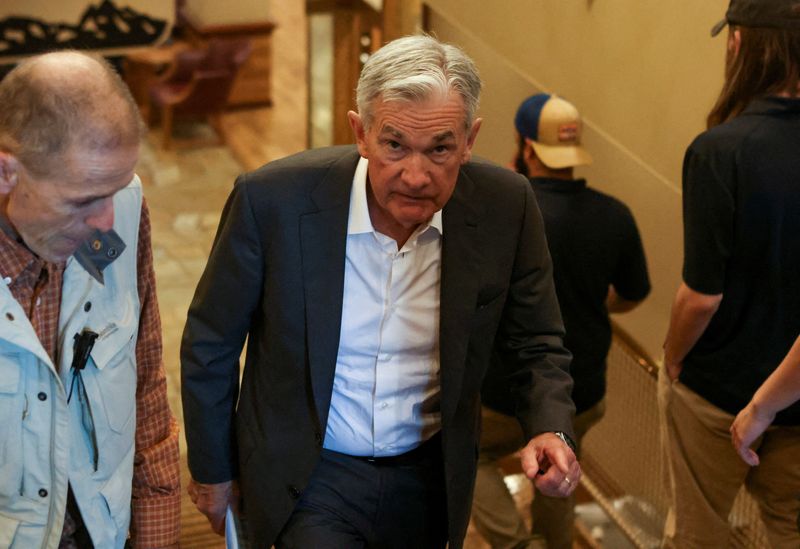By Jamie McGeever
ORLANDO, Florida (Reuters) -Jerome Powell’s Jackson Hole speech has turned Sept. 6 and Sept. 18 into the two most important dates for U.S. monetary policy in years, as events on both days center on the Fed’s new guiding light: the unemployment rate.
The first marks the release of the August non-farm payrolls report, and the second will see the Fed’s much-anticipated interest rate decision and, just as crucially, its updated Summary of Economic Projections (SEP).
The Fed will almost certainly cut rates on Sept. 18, as Powell signaled at Jackson Hole and as other officials have effectively confirmed since. The only questions now are whether the easing cycle starts with a 25- or 50-basis-point cut, and how much policy is loosened in the coming months.
After these two pivotal days in September, investors should have their answers.
DUAL PIVOTS
Powell essentially made two pivots in Jackson Hole. The first, as expected, is his clear signaling that a rate cut is forthcoming. The second, perhaps less anticipated, is his equally clear emphasis that unemployment, not inflation, is now the number one determinant of upcoming policy decisions.
Powell’s warning that the Fed does “not seek or welcome further cooling in labor market conditions” basically means the current unemployment rate of 4.3% – which is still fairly low by historical standards – is now a “line in the sand” that, if crossed, will likely trigger a policy response.
“The unemployment rate is now around 90% of the Fed’s dual mandate, inflation is about 10%,” said John Silvia, founder of Dynamic Economic Strategy, adding that Powell’s pivot to unemployment from inflation is remarkable considering the economy isn’t in recession.
ALL EYES ON SEPTEMBER
Of course, there’s more than one way of measuring the strength or otherwise of the labor market and, by extension, the economy. They include nominal job growth, the ebb and flow of the labor force, and one of the Fed’s favorites since the COVID-19 pandemic: the JOLTS estimates of outsized quits and job openings.
But for the public, markets at large and politicians, the unemployment rate offers the clearest picture of how well the labor market is holding up. This figure is doubly important now the U.S. presidential election is in full swing.
The unemployment rate rose two-tenths of a percentage point in July to 4.3%, the highest level since October 2021. It triggered the so-called Sahm rule, which states that a 0.5-percentage point rise in the three-month average unemployment rate from the low of the past year typically signals recession.
While economist Claudia Sahm, the rule’s creator, has poured cold water on claims that recession is now inevitable, she does note that the rise in unemployment is concerning. When it comes to rising unemployment, momentum typically cannot be slowed easily, much less reversed quickly.
What’s more, the current unemployment rate is now above Fed officials’ median long-term projection of 4.2%, published in the June SEP. And since the Fed began including median projections in its quarterly SEPs in 2015, major policy shifts have always coincided with the two crossing over.
This happened in late 2016 when the Fed started raising rates in earnest, in early 2020 when the pandemic prompted rates to be cut to zero, and in early 2022 when the Fed began its last hiking cycle.
So that’s why it’s so significant that both the unemployment rate and the Fed’s long-term outlook will be updated within days of each other. Changes in either will go a long way in determining the Fed’s path for the rest of this year and early 2025.
ROCKY OR SOFT LANDING?
Traders expect 100 basis points of easing by year end, and at least another 100 bps next year. And even though futures markets are still betting on the Fed delivering a quarter-point cut in September, the probability of a half-point move has a one-in-three chance.
So what happens if we see another solid rise in the unemployment rate on Sept. 6? This could seal the deal for a 50-basis-point cut on Sept. 18 and boost the case for similarly bold moves in the coming months.

A cutting cycle of that size and speed wouldn’t be easy for the Fed to navigate or communicate. Just as importantly, it will likely only occur if the U.S. truly is in the early stages of a recession, blowing apart the market’s “soft landing” narrative once and for all.
(The opinions expressed here are those of the author, a columnist for Reuters.)
(By Jamie McGeeverEditing by Helen Popper)


